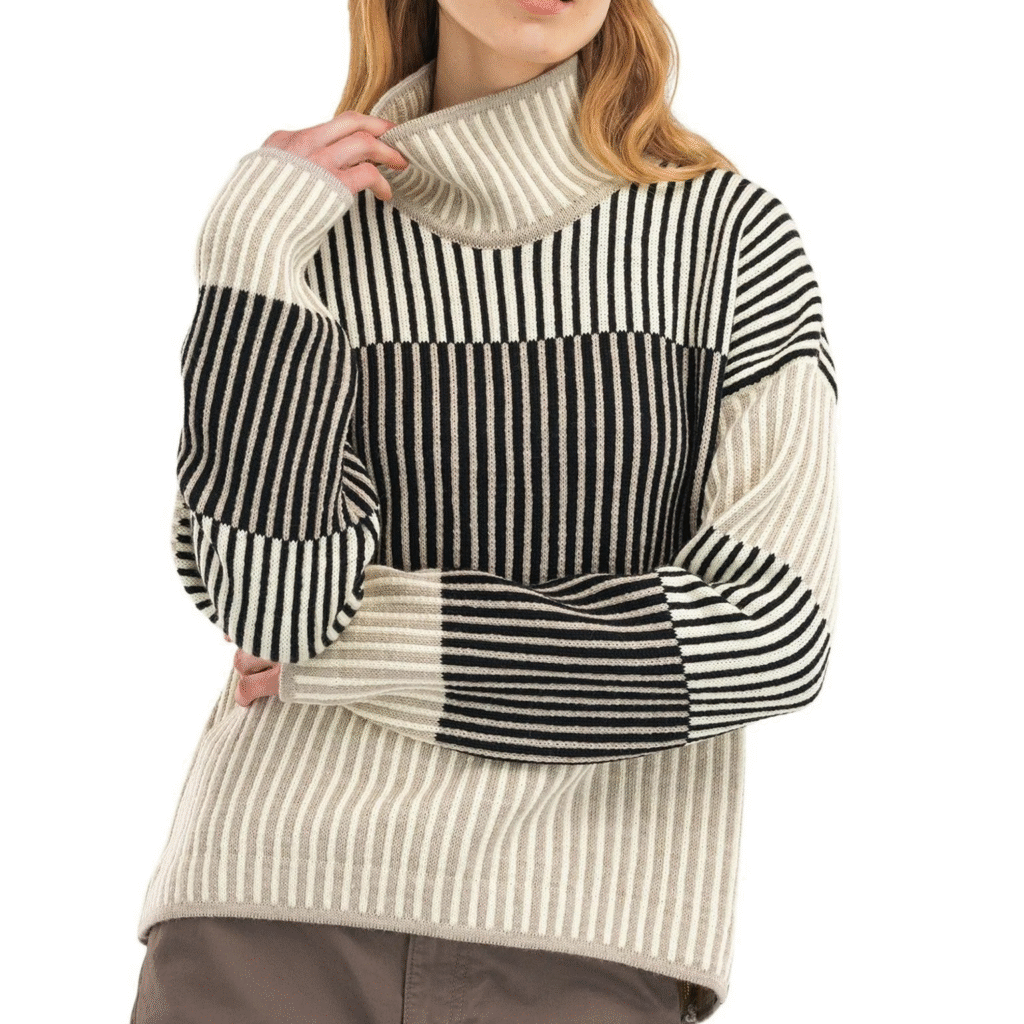Choosing the right yarn is a fundamental step in creating beautiful, comfortable, and durable knitwear. This article helps you make informed decisions when choosing yarn.

Table of Contents
Checklist for Choosing Yarn
- ✅ Define the Project Purpose
Consider the knitwear type, seasonality, and expected usage. Use breathable fibers (cotton, linen, silk) for summer; and warm fibers (wool, alpaca, cashmere) for winter.
- ✅ Understand Fiber Types
Choose natural fibers for softness & breathability, and synthetics for durability and easy care.
- ✅ Select Yarn Weight
Match the yarn weight (lace to bulky) to the desired texture and structure. Ensure needle size and gauge align with design needs.
- ✅ Evaluate Texture & Structure
Decide between plied (durable, defined stitches) and single-ply (soft, but prone to pilling).
- ✅ Check Drape and Hand Feel
Swatch to test how the yarn behaves—its softness, drape, and elasticity.
- ✅ Assess Color and Dyeing
Choose colors that complement your pattern. Natural fibers like wool and silk absorb dye better.
- ✅ Request Samples
Work with suppliers to test yarn swatches and check for quality, color, and consistency.
- ✅ Review Availability & Lead Times
Confirm stock status and delivery timelines, especially for bulk orders.
- ✅ Prioritize Sustainability
Opt for eco-friendly, certified, or recycled yarns when possible.
- ✅ Stay Updated
Follow yarn trend forecasts and visit industry fairs like Pitti Filati for innovation and inspiration.
Whether you are a designer developing a new collection or a passionate retailer crafting a project, it is essential to further understand how to select yarn based on fiber content, texture, weight, and purpose.
Understand Your Project Requirements
Before selecting yarn, it’s important to consider the design and intended use of the knitwear. Different yarns perform differently depending on the clothing type, season, and wearability requirements.
Seasonality: Lighter fibers like cotton, linen, and silk are ideal for spring and summer knitwear due to their breathability and moisture-wicking properties. Wool, alpaca, cashmere, and blends are preferred for fall and winter because of their warmth and insulation.
Texture and Drape: Some yarns create more structured, lofty fabrics (like bulky wool), while others, such as silk or cotton blends, create smooth and fluid drapes.
Durability and Care: Consider the wear and tear your knitwear will undergo. Yarns with synthetic blends tend to be more durable and wrinkle-resistant, whereas pure natural fibers may require delicate care.
Know the Types of Fibers
Yarns fall broadly into two categories: natural fibers and synthetic fibers.
- Natural Fibers
Wool is prized for its elasticity, warmth, and moisture-wicking abilities. Merino wool is especially fine and soft, suitable for garments worn close to the skin. Specialty wools such as alpaca, yak, and angora offer unique textures and warmth levels.
Cotton is breathable and soft but lacks elasticity. It’s excellent for summer polo and washable items.
Silk adds sheen and luxury, with a smooth texture and good strength. It’s often blended with other fibers for added drape and softness.
Linen and Hemp: These fibers provide a crisp, cool hand feel, ideal for summer T-shirt. They can be stiff and prone to wrinkling, so often blended with softer fibers.
- Synthetic Fibers
Common synthetics like acrylic, nylon, and polyester are valued for their durability, elasticity, and easy-care properties. They often improve strength and reduce cost when blended with natural fibers. However, they generally lack breathability and can generate static electricity.
Yarn Weight and Gauge Matter
Appropriate yarn weight is crucial for matching the desired fabric density and knitwear structure.
Yarn weights range from superfine lace to bulky and super bulky. Lightweight yarns produce delicate, fine textures, whereas bulky yarns give warm, voluminous fabrics.
The knitting needle size should correspond to the yarn weight to ensure proper gauge, affecting drape, elasticity, and overall fit.
Designers and knitters should swatch with proposed yarns to test gauge and fabric hand before committing to production.
Consider Yarn Structure and Texture
Plied vs. Single-ply: Plied yarns, made by twisting multiple strands, tend to be stronger and more durable, producing a balanced stitch definition. Single-ply yarns have a softer hand but can be prone to splitting and pilling.
Smooth vs. Textured Yarns: Smooth yarns, like mercerized cotton or silk blends, offer a crisp stitch definition ideal for intricate patterns. Textured yarns such as boucle or novelty yarns add visual interest and bulk but may obscure detailed stitches.
Color and Dyeing
Color choice impacts the perception of the knitwear’s style and wearability. Solid colors emphasize stitch patterns, while variegated or self-striping yarns provide visual texture.
Some fibers accept dye better than others; for example, wool and silk typically yield rich, deep colors, while cotton may require special dyeing techniques to achieve vibrancy.
Practical Actions for Choosing Yarn
Consult Yarn Exhibitions and Trend Forecasts: Trade shows like Pitti Filati provide the latest yarn innovations and trends from fancy novelty yarns to sustainable blends.
Request Yarn Samples and Color Cards: Collaborate closely with suppliers or factories to receive yarn swatches and knitwear sample. This hands-on approach helps evaluate texture, color, and suitability before bulk production.
Test Knit Swatches: Always knit small samples to assess fabric behavior, drape, and stitch definition. This is essential to confirm the compatibility of yarn and needle size for the desired design.
Factor in Availability and Lead Times: For large-scale production, check if the yarn is in stock or requires advance ordering, as some specialty yarns have long delivery times.
Consider Sustainability: Increasingly, designers and consumers prioritize eco-friendly fibers and responsible sourcing. Natural fibers with certifications or recycled yarns are gaining popularity.
Conclusion
Choosing yarn is a blend of art and science. It requires balancing aesthetic vision, technical constraints, wearability, and cost considerations. By understanding fiber properties, yarn structure, weight, and color effects, and by collaborating closely with suppliers and testing samples, designers and retailers can select yarns that bring their creative visions to life with optimal performance.
Reference: https://en.wikipedia.org/wiki/Yarn
Read more on material: https://onwardcashmere.com/how-to-choose-knitwear-materials/